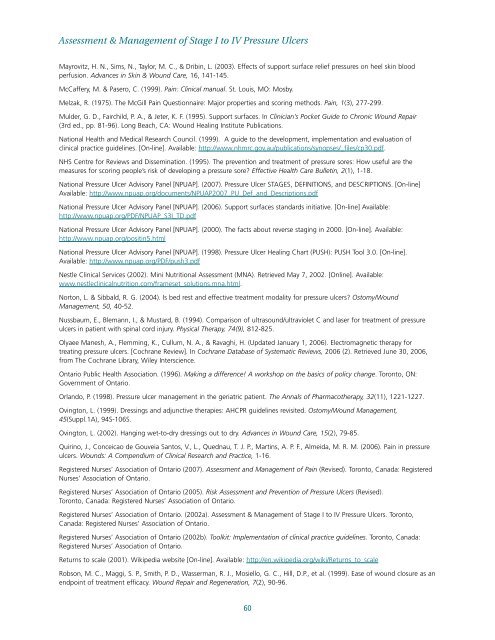RNAO BPG Pressure Ulcers Stage I to IV - Faculty of Health ...
RNAO BPG Pressure Ulcers Stage I to IV - Faculty of Health ...
RNAO BPG Pressure Ulcers Stage I to IV - Faculty of Health ...
You also want an ePaper? Increase the reach of your titles
YUMPU automatically turns print PDFs into web optimized ePapers that Google loves.
Assessment & Management <strong>of</strong> <strong>Stage</strong> I <strong>to</strong> <strong>IV</strong> <strong>Pressure</strong> <strong>Ulcers</strong>Mayrovitz, H. N., Sims, N., Taylor, M. C., & Dribin, L. (2003). Effects <strong>of</strong> support surface relief pressures on heel skin bloodperfusion. Advances in Skin & Wound Care, 16, 141-145.McCaffery, M. & Pasero, C. (1999). Pain: Clinical manual. St. Louis, MO: Mosby.Melzak, R. (1975). The McGill Pain Questionnaire: Major properties and scoring methods. Pain, 1(3), 277-299.Mulder, G. D., Fairchild, P. A., & Jeter, K. F. (1995). Support surfaces. In Clinician’s Pocket Guide <strong>to</strong> Chronic Wound Repair(3rd ed., pp. 81-96). Long Beach, CA: Wound Healing Institute Publications.National <strong>Health</strong> and Medical Research Council. (1999). A guide <strong>to</strong> the development, implementation and evaluation <strong>of</strong>clinical practice guidelines. [On-line]. Available: http://www.nhmrc.gov.au/publications/synopses/_files/cp30.pdf.NHS Centre for Reviews and Dissemination. (1995). The prevention and treatment <strong>of</strong> pressure sores: How useful are themeasures for scoring people’s risk <strong>of</strong> developing a pressure sore? Effective <strong>Health</strong> Care Bulletin, 2(1), 1-18.National <strong>Pressure</strong> Ulcer Advisory Panel [NPUAP]. (2007). <strong>Pressure</strong> Ulcer STAGES, DEFINITIONS, and DESCRIPTIONS. [On-line]Available: http://www.npuap.org/documents/NPUAP2007_PU_Def_and_Descriptions.pdfNational <strong>Pressure</strong> Ulcer Advisory Panel [NPUAP]. (2006). Support surfaces standards initiative. [On-line] Available:http://www.npuap.org/PDF/NPUAP_S3I_TD.pdfNational <strong>Pressure</strong> Ulcer Advisory Panel [NPUAP]. (2000). The facts about reverse staging in 2000. [On-line]. Available:http://www.npuap.org/positin5.htmlNational <strong>Pressure</strong> Ulcer Advisory Panel [NPUAP]. (1998). <strong>Pressure</strong> Ulcer Healing Chart (PUSH): PUSH Tool 3.0. [On-line].Available: http://www.npuap.org/PDF/push3.pdfNestle Clinical Services (2002). Mini Nutritional Assessment (MNA). Retrieved May 7, 2002. [Online]. Available:www.nestleclinicalnutrition.com/frameset_solutions.mna.html.Nor<strong>to</strong>n, L. & Sibbald, R. G. (2004). Is bed rest and effective treatment modality for pressure ulcers? Os<strong>to</strong>my/WoundManagement, 50, 40-52.Nussbaum, E., Blemann, I., & Mustard, B. (1994). Comparison <strong>of</strong> ultrasound/ultraviolet C and laser for treatment <strong>of</strong> pressureulcers in patient with spinal cord injury. Physical Therapy, 74(9), 812-825.Olyaee Manesh, A., Flemming, K., Cullum, N. A., & Ravaghi, H. (Updated January 1, 2006). Electromagnetic therapy fortreating pressure ulcers. [Cochrane Review]. In Cochrane Database <strong>of</strong> Systematic Reviews, 2006 (2). Retrieved June 30, 2006,from The Cochrane Library, Wiley Interscience.Ontario Public <strong>Health</strong> Association. (1996). Making a difference! A workshop on the basics <strong>of</strong> policy change. Toron<strong>to</strong>, ON:Government <strong>of</strong> Ontario.Orlando, P. (1998). <strong>Pressure</strong> ulcer management in the geriatric patient. The Annals <strong>of</strong> Pharmacotherapy, 32(11), 1221-1227.Oving<strong>to</strong>n, L. (1999). Dressings and adjunctive therapies: AHCPR guidelines revisited. Os<strong>to</strong>my/Wound Management,45(Suppl.1A), 94S-106S.Oving<strong>to</strong>n, L. (2002). Hanging wet-<strong>to</strong>-dry dressings out <strong>to</strong> dry. Advances in Wound Care, 15(2), 79-85.Quirino, J., Conceicao de Gouveia San<strong>to</strong>s, V., L., Quednau, T. J. P., Martins, A. P. F., Almeida, M. R. M. (2006). Pain in pressureulcers. Wounds: A Compendium <strong>of</strong> Clinical Research and Practice, 1-16.Registered Nurses’ Association <strong>of</strong> Ontario (2007). Assessment and Management <strong>of</strong> Pain (Revised). Toron<strong>to</strong>, Canada: RegisteredNurses’ Association <strong>of</strong> Ontario.Registered Nurses’ Association <strong>of</strong> Ontario (2005). Risk Assessment and Prevention <strong>of</strong> <strong>Pressure</strong> <strong>Ulcers</strong> (Revised).Toron<strong>to</strong>, Canada: Registered Nurses’ Association <strong>of</strong> Ontario.Registered Nurses’ Association <strong>of</strong> Ontario. (2002a). Assessment & Management <strong>of</strong> <strong>Stage</strong> I <strong>to</strong> <strong>IV</strong> <strong>Pressure</strong> <strong>Ulcers</strong>. Toron<strong>to</strong>,Canada: Registered Nurses’ Association <strong>of</strong> Ontario.Registered Nurses’ Association <strong>of</strong> Ontario (2002b). Toolkit: Implementation <strong>of</strong> clinical practice guidelines. Toron<strong>to</strong>, Canada:Registered Nurses’ Association <strong>of</strong> Ontario.Returns <strong>to</strong> scale (2001). Wikipedia website [On-line]. Available: http://en.wikipedia.org/wiki/Returns_<strong>to</strong>_scaleRobson, M. C., Maggi, S. P., Smith, P. D., Wasserman, R. J., Mosiello, G. C., Hill, D.P., et al. (1999). Ease <strong>of</strong> wound closure as anendpoint <strong>of</strong> treatment efficacy. Wound Repair and Regeneration, 7(2), 90-96.60
















